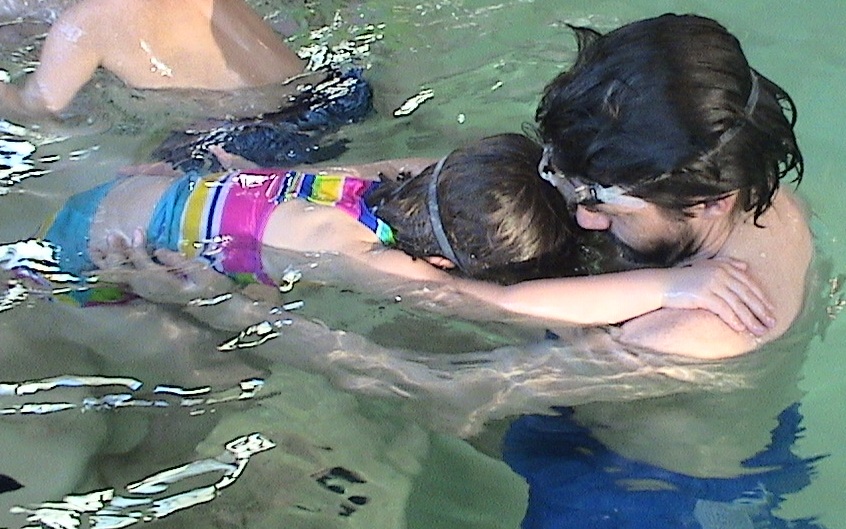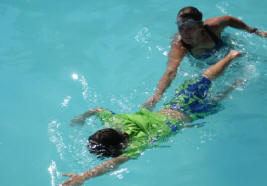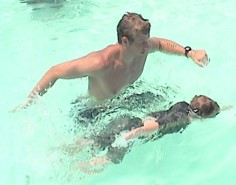New students should continue reading below before reviewing policies and enrolling.
Behavior expectations, makeup class policy and more can be found here.
Returning students can go directly to the enrollment page.
Ability: Degree of Autonomy (Measured in Distance)
Ability 1

Ability 2

Ability 3

Ability 1
Criteria: The student is cautious or has a fear of the water. The student will not move through the water to the instructor without “Buoyancy Support” from the instructor. Buoyancy Support means that the instructor holds the student’s abdomen, providing buoyancy assistance, as the student attempts to perform \ assimilate multiple Thematic Movements. Thus, the student’s ability of autonomy, as measured in distance, is 0 feet.
Focus: The focus of Ability 1 is to instruct students in basic safety; and in the proper motor skill coordination for swimming Freestyle and floating on the back. For Ability 1 students, all activities are done with total Buoyancy Support from the instructor.
The students are introduced to Freestyle: Buoyancy Control, Breathing Control, Kicking (leg movements) and Pulling (arm movements). Throughout each session of lessons, the students learn to assimilate these Thematic Movements together to perform the Freestyle stroke with Buoyancy Support from the instructor. Each student also learns and recites safety rules.
The goal is to enable students to perform these skills with minimal Buoyancy Support and eventually without the Buoyancy Support of the instructor.
Ability 2
Criteria: The student can move through the water at least 10 feet without Buoyancy Support from the instructor.
Focus: In addition to the skills listed for Ability 1, the students perform “Gliding” without Buoyancy Support. This Frontglide (Buoyancy Control + Breathing Control) eventually develops into an attempt at Freestyle as students assimilate Kicking (leg movements) and Pulling (arm movements). The end goal for Ability 2 is that the students swim Freestyle for 25 feet (8+ yards) with good technique. Good technique is defined by specific criteria on the Student Ability Report, which each student receives on the final day of class for each session.
Students are introduced to very practical safety skills. These include Backfloat (floating on the back without Buoyancy Support from the instructor) and our Self-Rescue Plan for Short Distance. This self-rescue plan has two phases. Students jump into deep water, in which they fully submerge. They learn to take a quick breath and exhale from their nose as they enter the water. They learn to pull themselves back up to the surface and take a quick breath. In the first phase, students attempt to arch into an autonomous Backfloat. While attempting to Backfloat, they call for help. In the second phase, students search for the wall, take a breath and swim Freestyle back to the wall. Many parents have told us that these skills have made a critical difference when their child(ren) have ventured too far from the edge of the pool. The students are also introduced to practical and basic Peer Rescue Skills.
Ability 3
Criteria: The student can move through the water at least 30 feet without Buoyancy Support from the instructor.
Focus: The focus for Ability 3 is that the students refine Freestyle for the purpose of aquatic enjoyment. The end goal for Ability 3 is that the students swim Freestyle for 75 feet (25 yards) with excellent technique. Excellent technique is defined by specific criteria on the Student Ability Report, which each student receives on the final day of class for each session. To accomplish this, students learn to extend the shoulder and back, thereby causing a “body roll” that permits lateral breathing and enables them to swim longer distances.
We continue to emphasize safety via our Self-Rescue Plan for Long Distance, in which the students learn how to transition between Freestyle and Backfloat. The students learn to roll over from Freestyle to a Backfloat. While backfloating, they learn to stay calm and control their breathing rate. When they have had sufficient rest, they roll back over and continue swimming. Successful implementation of this safety plan allows the students to swim longer distances by resting in a Backfloat as necessary. Many parents have told us that this safety plan has given their child(ren) the self confidence needed to feel comfortable in the water and enjoy going to the pool or swimming in supervised open-water settings.
Level: Degree of Proficiency (Technique while Traversing the Distance)
A
Performance of Individual Thematic Movements: “Buoyancy Control,” “Breathing Control,” “Kicking” and “Pulling” are the four Thematic Movements that comprise the essential components of every stroke. A “Level A” student is working toward performing, or may successfully perform, individual Thematic Movements in isolation but cannot yet successfully assimilate multiple Thematic Movements.
B
Simultaneous Assimilation of Two Thematic Movements: Before the student can assimilate all of the Thematic Movements itemized in Level A above, he/she must first begin simultaneously assimilating different combinations of two Thematic Movements. A “Level B” student is 80% successful in performing all individual Thematic Movements in isolation (thus has graduated from Level A) but cannot yet successfully assimilate the various combinations of two Thematic Movements. Thus, they are working on Level B criteria.
C
Simultaneous Assimilation of Three Thematic Movements. A “Level C” student is 80% successful in assimilating two Thematic Movements (thus has graduated from Level B) but cannot yet successfully assimilate the various combinations of three Thematic Movements. Thus, they are working on Level C criteria.
D
Simultaneous Assimilation of Four Thematic Movements:At this level, the student is now assimilating all of the information learned into one focus – Swimming! A “Level D” student is 80% successful in assimilating three Thematic Movements (thus has graduated from Level C) but cannot yet successfully assimilate the four Thematic Movements with a demonstration of excellent technique. Thus, they are working on Level D criteria.
E
Student demonstrates 90% proficiency of a given stroke (Freestyle as related to this specific table). A “Level E” student is 90% successful in assimilating the four Thematic Movements and thus has graduated from Level D.
A student with an Ability Level of 1D has demonstrated the ability to assimilate all four Thematic Movements for Freestyle (proficiency Level D), but is not yet able\willing to do so without Buoyancy Support from the instructor (autonomy Ability 1). In other words, even though the student cannot yet swim autonomously, he/she is basically doing a “stationary” Freestyle stroke. This is an excellent foundation and when the student develops the courage and confidence to push away from the edge of the pool autonomously, he\she will have the “muscle memory” necessary to swim with a good level of proficiency! Conversely, a student with an Ability Level of 3A has demonstrated an ability\willingness to “swim” (move through the water) at least 30 feet autonomously (autonomy Ability 3) but has not yet demonstrated the successful assimilation of multiple thematic movements while traversing 75 feet (proficiency Level A). In other words, he\she can “cover the distance” but has yet to do so using a proficient Freestyle stroke.
2021 Session Schedule
| We are now enrolling! | |||
| Location Key: TVoL = Town Village of Leawood | |||
| Due to the uncertainty of the pandemic, Jeff has made a decision that we will not offer a spring program. We plan to begin our 2021 swim instruction season in early June, in hopes that the vaccines will be available to the general population by then. We understand that other swim instruction providers are currently offering their services; and others will begin sooner than we are willing to do so. Our "style" of teaching is very "personalized". As Jeff has always said to new instructors through the years, "We do full contact teaching." We cannot most-effectively implement the teaching methodologies and techniques of our unique "Personalized Swim Instruction" curriculum while adhering to the restrictions (wearing of masks and physical distancing) necessary to protect the instructors and students. We are hopeful that such restrictions will be unnecessary (at least in an "aquatic classroom" environment) by the start of our first 2021 session, which will be named, "Session 4". However, we will retain the historical connection regarding the naming system of our sessions. Specifically, during the seasons in which we had begun in March, that session was always "Session 1", with "Session 2" starting in late March or early April, etc. For the aforesaid reasons, we will not offer Sessions 1 through 3 this season. Again, we will begin with "Session 4." | |||
| Summer Sessions | Mon through Thurs for 2 Weeks | Location | Class Times |
| Session 4 | June 7 - June 17 | TVoL | Children’s Classes (all PM): 2:00 to 2:35; 2:35 to 3:10; 3:10 to 3:45; 3:50 to 4:25; 4:25 to 5:00; 5:00 to 5:35; 5:35 to 6:10; 6:10 to 6:45; 6:55 to 7:30; 7:30 to 8:05. |
| Session 5 | June 21 - July 1 | TVoL | Children’s Classes (all PM): 2:00 to 2:35; 2:35 to 3:10; 3:10 to 3:45; 3:50 to 4:25; 4:25 to 5:00; 5:00 to 5:35; 5:35 to 6:10; 6:10 to 6:45; 6:55 to 7:30; 7:30 to 8:05. |
| Session 6 | July 6* - July 15 | TVoL | Children’s Classes (all PM): 2:00 to 2:35; 2:35 to 3:10; 3:10 to 3:45; 3:50 to 4:25; 4:25 to 5:00; 5:00 to 5:35; 5:35 to 6:10; 6:10 to 6:45; 6:55 to 7:30; 7:30 to 8:05. Teen\Adult Classes: 8:10 to 9:20 on Mon\Wed or Tues\Thurs. |
| *Due to July 4 being on a Sunday, we want to provide our customers and instructors with an extra day for travel, etc. before starting this session. Therefore, the first week of Session 6 will be held Tuesday through Friday, with a potential makeup day on Saturday. The second week will be the usual Monday through Thursday with Friday as a potential makeup day. | |||
| Session 7 | July 19 - July 29 | TVoL | Children’s Classes (all PM): 2:00 to 2:35; 2:35 to 3:10; 3:10 to 3:45; 3:50 to 4:25; 4:25 to 5:00; 5:00 to 5:35; 5:35 to 6:10; 6:10 to 6:45; 6:55 to 7:30; 7:30 to 8:05. Teen\Adult Classes: 8:10 to 9:20 on Mon\Wed or Tues\Thurs. |
| Session 8 | August 2 - August 12 | TVoL | If sufficient interest and instructor availability |
| Session 9 | August 16 - August 26 | TVoL | If sufficient interest and instructor availability |
Tuition
Tuition for our standard group sessions of 4 students per class for eight (8) 35-minute lessons is $100 per student. Tuition for our standard Teen \ Adult group sessions of 4 students per class for four (4) 70-minute lessons is also $100 per student.
We limit our class size to four students. If you want the option of having fewer than four students in a class, your tuition will be directly proportional to our standard group class of four students, as detailed in this tuition chart:
| Group Class: 4 Students | Group Class: 3 Students | Semi-Private: 2 Students | Private: 1 Student |
| Per Student | Per Student | Per Student | |
| $100.00 | $133.33 | $200.00 | $400.00 |
$35 Off Per Student!
To thank our customers for allowing us to thrive for 35 years, we are offering $35 OFF Per Student for Each Student’s First 2021 Session. All students are eligible, whether learning with us for the first time or continuing for another season. Each student is eligible for this discount once and it is applicable to any of the sessions.
New to Our Program?
Please review our policies and procedures before advancing to the enrollment page.
Ready to Enroll?
You can go directly to our enrollment page.
Summer Employment
We will be hiring soon for Swim Instructors, Lifeguards and Pool Managers.
